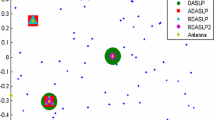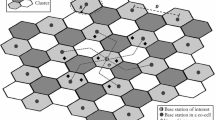Abstract
We consider the use of distributed antennas to increase the capacity and peak data rate achievable in a microcellular CDMA system with limited bandwidth. In additon to the diversity against Rayleigh fading achievable by use of microdiversity among nearly co-located transmit or receive antennas, we exploit macrodiversity against shadow fading that more widely separated antennas permit. We report on antenna configurations for both directional and omni-directional antennas that provide the most uniform signal-to-interference ratio coverage, averaged over a large number of position vectors drawn from a spatially uniform distribution of mobiles. Call capacities and peak transmission rates are determined for an integrated system carrying traffic at different constant rates, where processing gain and the transmission rate are selected to satisfy a common chip rate. For the downlink a 5.5 dB capacity gain can be achieved for 64 kb/s calls using four antennas located on the diagonals of each square cell. A bandwidth of 5 MHz allows two or more calls to be simultaneously supported at data rates up to 512 kb/s, as opposed to only 128 kb/s for three co-located antennas. On the uplink we distinguish between the computationally simpler equal-gain combining of the antenna signals and the possibly more complex maximum-ratio combining. With equal gain combining we achieve a peak data rate of 128 kb/s and a capacity gain of 2.5 dB relative to equal gain combining of three nearly co-located antenna signals. With maximum ratio combining the peak uplink rate can be as high as 512 kb/s and the capacity is increased by 2.0 dB relative to the maximum-ratio combining of three co-located antennas.
Similar content being viewed by others
References
A.J. Viterbi, CDMA: Principles of Spread Spectrum Communications, Addison-Wesley Publising Company: Reading, MA, 1995.
Qualcomm. Inc., Proposed EIA/TIA Interim Standard: Wideband Spread Spectrum Digital Cellular System Dual-Mode Mobile Station - Base Station Compatibility Standard, TIATR45.5, 1992.
P. Mermelstein and S. Kandala, "Capacity Estimates for Mixed-Rate Traffic on The Integrated Wireless Access Network", Proc. Sixth Intl. Symp. Personal, Indoor, Mobile Radio Commun., 1995.
A.J. Viterbi, A.M. Viterbi, K.S. Gilhousen and E. Zehari, "Soft Handoff Extends CDMA Cell Coverage and Increases Reverse Link Capacity", IEEE J. Select. Areas Commun., Vol. 12, No. 8, pp. 1281–1288, 1994.
A.J. Viterbi and A.M. Viterbi, "Erlang Capacity of a Power Controlled CDMA System", IEEE J. Select. Areas Commun., Vol. 11, No. 6, pp. 892–900, 1993.
R. Padovani, "Reverse Link Performance of IS'95 Based Cellular Systems", IEEE Pers. Commun. Mag., Vol. 1, No. 3, pp. 28–34, 1994.
A. Jalali and P. Mermelstein, "Effects of Diversity, Power Control, and Bandwidth on the Capacity of Microcellular CDMA Systems", IEEE J. Select. Areas Commun., Vol. 12, 1994.
K.S. Gilhousen, I.M. Jakobs, R. Padovani, L. Viterbi, A. Weaver, and C.E. Wheatley, "On the Capacity of a Cellular CDMA System", IEEE Trans. Vehic. Technol., Vol. 40, pp. 303–312, 1991.
A. Salmasi and K.S. Gilhousen, "On the System Design Aspects of Code Division Multiple Access (CDMA) Applied to Digital Cellular and Personal Communications Network", Proc. 41st IEEE Vehic. Technol. Conf., 1991.
R.C. Bernhardt, "RF Performance of Macroscopic Diversity in Universal Digital Portable Radio Communications: Signal Strength Considerations", Proc. IEEE Globecom '85, pp. 32.7.1–32.7.6, 1985.
P. Chow, A. Karim and V. Fung, "Performance Advantages of Distributed Antennas in Indoor Wireless Communication Systems", Proc. IEEE Conf. Vehic. Technol., pp. 1522–1526, 1994.
A.A.M. Saleh, A.J. Rustako and R.S. Roman, "Distributed Antennas for Indoor Radio Communications", IEEE Trans. Commun., Vol. COM35, pp. 1245–1251, 1987.
K.J. Kerpez, "A Radio Access System with Distributed Antennas", IEEE Trans. Vehic. Technol., Vol. 45, pp. 265–275, 1996.
R.C. Bernhardt, "Macroscopic Diversity in Frequency Reuse Radio Systems", IEEE J. Select. Areas Commun., Vol. SAC5, pp. 862–870, 1987.
W.C.Y. Lee, Mobile Cellular Telecommunication Systems, McGrawHill: New York, 1989.
W.C. Jakes, Microwave Mobile Communications, Wiley and Sons: New York, 1974.
G. Wu, A. Jalali and P. Mermelstein, "On Channel Model Parameters for MicroCellular CDMA Systems", IEEE Trans. Vehic. Technol., Vol. 44, pp. 706–711, 1995.
D.J. Torrieri, "Performance of Direct-Sequence Systems with Long Pseudonoise Sequences", IEEE J. Select. Areas Commun., Vol. 10, No. SAC4, pp. 770–781, 1992.
G. Stuber, Principles of Mobile Communications, Kluwer Academic Publishers, 1996.
F. Ling, "Coherent Detection with Reference-Symbol Based Channel Estimation for Direct-Sequence CDMA Uplink Communication", Proc. VTC '93, pp. 400–403, 1993.
Author information
Authors and Affiliations
Rights and permissions
About this article
Cite this article
Bdira, E.B., Mermelstein, P. Exploiting Macrodiversity with Distributed Antennas in Micro-Cellular CDMA Systems. Wireless Personal Communications 9, 179–196 (1999). https://doi.org/10.1023/A:1018354918175
Issue Date:
DOI: https://doi.org/10.1023/A:1018354918175




